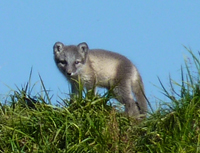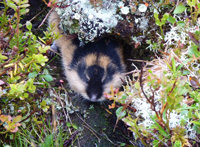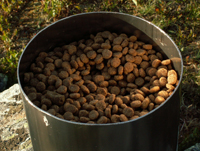| |
|
|
| |
Abstract
Life history traits in a cyclic ecosystem
– a field experiment of the arctic fox
The reproduction of many species depends strongly on variation in food availability. The main prey of the arctic fox in Fennoscandia are cyclic small rodents, and its number of litters and litter size vary depending on the phase of the rodent cycle. In this experiment, we studied if the arctic fox adjusts its reproduction as a direct response to food abundance, in accordance with the food limitation hypothesis, or if there are additional phase-dependent trade-offs that influence its reproduction. We analysed the weaning success, i.e. proportion of arctic fox pairs established during mating that wean a litter in summer, of 422 pairs of which 361 were supplementary winter fed, as well as the weaned litter size of 203 litters of which 115 were
supplementary winter fed. Females without supplementary winter food over-produced cubs in relation to food abundance in the small rodent increase phase, i.e. the litter size was equal to that in the peak phase when food was more abundant. The litter size for unfed females was 6.38 in the increase phase, 7.11 in the peak phase and 3.84 in the decrease phase. The litter size for supplementary winterfed litters was 7.95 in the increase phase, 10.61 in the peak phase and 7.86 in the decrease phase. Thus, feeding had a positive effect on litter size, but it did not diminish the strong impact of the small rodent phase, supporting phase-dependent trade-offs in addition to food determining arctic fox reproduction.
Reference
Meijer T, Elmhagen B, Eide NE, Angerbjörn A (2013) Life history traits in a cyclic ecosystem – a field experiment of the arctic fox.Oecologia 173: 439-447. |
|
| |
|
|
| |

The rodent cycle implies drastic variation in food abundance for rodent-depending predators, such as rough-legged buzzard (Buteo lagopus, left), long-tailed skua (Stercorarius longicaudus, middle) and arctic fox (Vulpes lagopus, right).
IIIIIIn this study, we tested if supplemental food affects the reproductive success of arctic foxes. The results suggest that the arctic fox has evolutionary adaptations to the rodent cycle, which other food sources cannot fully compensate for.
|
|
|
| |
| |
 Arctic fox cub (Vulpes lagopus)
Arctic fox cub (Vulpes lagopus) |
| |
 Lemming (Lemmus lemmus).
Lemming (Lemmus lemmus).
Small rodents (lemmings and voles) generally display cyclic dynamics. The cycle can be divided into year-long phases: low, increase, peak and decrease.
|
| |
 Inhabited arctic fox dens were provided with supplemental food (dog food pellets).
Inhabited arctic fox dens were provided with supplemental food (dog food pellets). |
|
